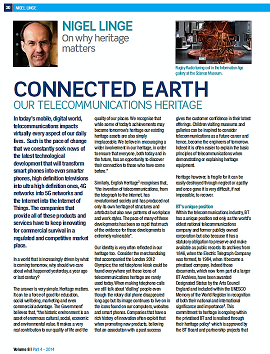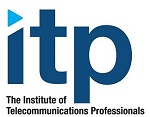Connected Earth - our telecommunications heritage

This paper was published in 2014 within the Journal of the Institute of Telecommunications Professionals (Volume 8, Part 4, Pages 30-33) and is made available here with their kind permission.

Introduction
Telecommunications impacts virtually every aspect of our daily lives. Such is the pace of changethat we constantly seek news of the latest technological development that will transform smart phones into even smarter phones, high definition televisions into ultra high definition ones, 4G networks into 5G networks and the Internet into the Internet of Things. The companies that provide all of these products and services have to keep innovating for commercial survival in a regulated and competitive market place.
In a world that is increasingly driven by what is coming tomorrow, why should we care about what happened yesterday, a year ago or last century? The answer is very simple. Heritage matters. It can be a force of good for education, social wellbeing, marketing and even commercial advantage. The Government believes that, “the historic environment is an asset of enormous cultural, social, economic and environmental value. It makes a very real contribution to our quality of life and the quality of our places. We recognise that while some of today’s achievements may become tomorrow’s heritage our existing heritage assets are also simply irreplaceable. We believe in encouraging a wider involvement in our heritage, in order to ensure that everyone, both today and in the future, has an opportunity to discover their connection to those who have come before.”
Similarly, English Heritage recognises that, “the invention of telecommunications, from the telegraph to the Internet, has revolutionised society and has produced not only its own heritage of structures and artefacts but also new patterns of workplace and work styles. The pace of many of these developments has been so rapid that much of the evidence for those developments is extremely vulnerable.”
Our identity is very often reflected in our heritage too. Consider the merchandising that accompanied the London 2012 Olympics; the red telephone kiosk could be found everywhere yet these icons of telecommunications heritage are rarely used today. When making telephone calls we still talk about ‘dialling’ people even though the rotary dial phone disappeared long ago but its image continues to live on in the icons found on our computers, websites and smart phones. Companies that have a rich history of innovation often exploit that when promoting new products, believing that an association with a past success gives the customer confidence in their latest offerings. Children visiting museums and galleries can be inspired to consider telecommunications as a future career and hence, become the engineers of tomorrow. Indeed it is often easier to explain the basic principles of telecommunications when demonstrating or explaining heritage equipment.
Heritage however, is fragile for it can be easily destroyed through neglect or apathy and once gone it is very difficult, if not impossible, to recover.


Follow on social media .....